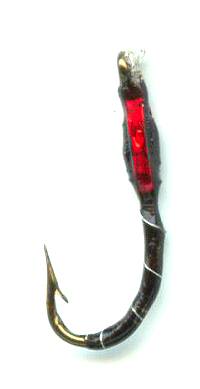Black and Red Flash Epoxy Buzzer Midge
To catch trout or grayling the Black and Red Flash Epoxy Buzzer Midge Nymph should be fished as part of a team of three flies on droppers under a floating strike indicator or dry fly.

EPOXY BUZZER FLY PATTERNS. Hook size 12 14 16 18 20 24 - $US each
If the river is in spate after heavy rainfall and is a milk chocolate or a muddy green color do not pack up your fishing rod and go home. You will be missing out on a lot of fun fishing if you do. Stronger flows are associated with colored water and they flush out aquatic nymphs and larvae. The trout are very aware of this but seek out calmer water to ride out the spate. They are not silly. They will not waste energy swimming in the fastest sections of water. Fly color is important. Do not choose flies that match the color of the water. Brighter shades like red, orange and pink are a great choice but do not forget that black stands out surprisingly well in colored water. The added red flash on the cheeks of the Black and Red Flash Epoxy Buzzer Midge Nymph fly helps attract the trout's attention.
It is the fly fishermen that get put off in these conditions not the fish. They know that if they wait, fast food will speed past them. All they have to do is grab lunch when it comes within range. I fish with a short fixed line. The fish cannot see you. Yes you can only cover a small part of the river at a time but by picking your locations carefully you can have great success. Look for the slack water and try there. If you have no luck walk along the bank to the next zone of slack water. When currents hit riverbanks the friction reduces the flow rate and can create pockets of more comfortable slack water for the trout. The fish could be right near your feet without you knowing it. The lee of water obstructions like large rocks, bridge pillars or tree roots are also great slack water locations. Keep your droppers close together. If the trout can see one he will soon be able to see one of the others. This should tempt him to make a grab for one of them. I keep the heaviest fly on the point and lighter flies further up the line. I make short casts and watch the joint between leader and line for indication as to movement. If you prefer you could add a strike indicator. Finally remember to take care when wading in a river in flood.
During the cold winter months the water is very often clear and the fish will have a greater opportunity to examine your fly. It is therefore even more important to closely imitate the natural food. One of the most important winter foods of a trout's diet is the midge. It is one of the few things that are going to be active this time of the year at the bottom of a lake, pond or reservoir. As previously mentioned it starts its life as a bloodworm larva and then changes into a buzzer pupa. The buzzer can swim and can be found anywhere in the water column. For my winter rig I like to fish with a bloodworm pattern as my point fly and buzzer patterns on droppers. I like to keep my droppers close to the lake bed and the bottom feeding trout so I keep them only two to three feet apart. As the temperature of the water rises, if you are lucky to be blessed with a sunny winters day, I move the droppers further apart and higher in the water column to the height where I think the naturals are swimming and therefore the hungry trout. The buzzers are a lot smaller then in the summer. A size 10 buzzer just will not do. Put on the smallest buzzer you have and choose a black or olive pattern.
Customer's Comment
Over the years I have caught loads of fish on this skinny little red flash black epoxy buzzer pattern. What I like about it is the close representation to the natural midge pupa. It can be fished with great success as a team on a straight through leader or fished under a bung when the fish want the fly static. If used on a large hook version it sinks like a stone, making it great for deep water nymphing. It works successfully right through the fishing season, although it really finds favour between April to the end of June. John Mallow, York
Customer's Comment
Over the years I have caught loads of fish o this skinny little pattern. What I like about it is the close representation to the natural midge pupa. It can be fished with great success as a team on a straight through leader or fished under a bung when the fish want the fly static. If used on a large hook version it sinks like a stone, making it great for deep water nymphing. It works successfully right through the fishing season, although it really finds favour between April to the end of June. John Mallow, York.


